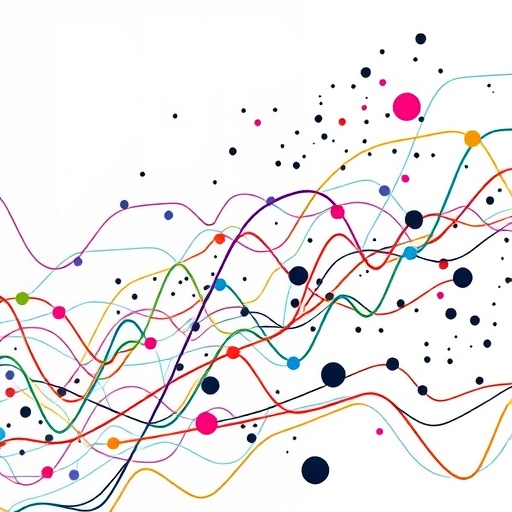In an era where mental health is becoming increasingly relevant to our societal well-being, the scientific community is fervently exploring innovative ways to decode the complexities of psychological disorders. A pioneering study by S.V. George, titled “Chaos to clarity: interpreting time series complexity metrics with an application to depression,” published in the journal Discover Mental Health, embarks on this crucial quest to better understand the intricacies of depression through advanced methodologies. Time series complexity metrics have traditionally served as a diagnostic measure, yet George’s research boldly pushes the boundaries of these metrics, utilizing them as a lens for interpreting the chaotic nature of mental health disorders.
At its core, George’s study interrogates the traditional frameworks employed in assessing depression. Rather than relying solely on qualitative assessments or standardized screening tools, the research proposes a quantitative approach that delves into the temporal dynamics of emotional states. Through this approach, it became evident that episodes of depression exhibit not merely flatlining patterns, but rather a complex interplay of factors that show chaotic behavior over time. This finding is crucial; it reframes the understanding of depression, suggesting that fluctuations in emotional states reflect deeper underlying patterns that could offer insights into potential interventions.
The innovation lies in the introduction of time series analysis as an interpretive tool for mental health. By examining sequential data over time, George illustrates how emotional responses to the external world can display chaotic patterns. This idea is rooted in the concept of dynamic systems, where seemingly random or chaotic behavior can emerge from underlying deterministic processes. The implications of these findings are vast, as they can fundamentally shift how clinicians approach the treatment of depression. Instead of merely treating symptoms in a piecemeal fashion, understanding the chaos can lead to targeted therapies that address these underlying dynamics.
George’s research emphasizes the importance of understanding individual differences in response to therapeutic interventions. The study’s data reveals a fascinating spectrum of reactions to treatment among individuals, which correlates with the identified chaos in their emotional patterns. This nuanced understanding could prove transformative, shaping personalized treatment protocols that are fine-tuned to the chaotic behaviors exhibited by each patient. This bespoke approach not only acknowledges the complexities of mental health but also respects the individuality of each patient’s experience with depression.
Furthermore, the study showcases the power of technology in mental health research. High-density electroencephalography (EEG), advanced data mining techniques, and sophisticated modeling were pivotal in extracting meaningful patterns from vast chronological datasets. For instance, the use of machine learning algorithms to parse through EEG data presents an innovative pathway for recognizing patterns of emotional activity, providing stakeholders with a clear, data-driven pathway to understanding depressive episodes. The convergence of technology and mental health research holds the promise of yielding unprecedented insights into treatment efficacy and patient outcomes.
The analysis also draws attention to the limitations of conventional approaches, particularly the binary classification systems used in mental health diagnostics. This binary perspective often overlooks the shades of gray that exist in human emotions. The chaos theory applied by George allows for a stratified understanding of depression that encompasses a spectrum of emotional experiences, enhancing diagnostic accuracy. With such intricate modeling, healthcare providers could forge stronger paths to effective care by moving beyond simplistic categorizations.
An additional layer of interest in George’s research is its potential application in preventive measures. By identifying chaos in emotional states before they culminate in severe depressive episodes, interventions could be implemented earlier, potentially mitigating the progression of these episodes. This forward-thinking approach could lead to structured programs that educate individuals on recognizing signs of emotional upheaval and employing techniques to restore balance before chaos ensues. Such preventative measures could transform the way mental health issues are addressed, focusing on resilience and positive emotional regulation.
Moreover, the research provokes a conversation around the social implications of understanding chaos in mental health. As society grapples with an increasingly visible mental health crisis, a deeper understanding of depression could encourage open dialogues and reduce stigma. By framing mental health disorders as complex phenomena rather than mere personal failures or shortcomings, George’s work signals a cultural shift towards compassion and support for those grappling with such issues. This shift can not only empower individuals but also galvanize communities and policy makers to invest in mental health infrastructure and support systems.
In exploring the breadth of chaos theory’s relevance in mental health, George raises the possibility of interdisciplinary collaboration. As fields such as psychology, neuroscience, and data science intersect, the potential emerges for groundbreaking advancements in understanding human behavior and mental processes. Encouraging cross-disciplinary dialogues could cultivate new methodologies and insights that enrich both scientific inquiry and practical applications in mental health treatment.
In conclusion, S.V. George’s study opens the door to a new paradigm in understanding depression through the lens of chaos and complexity. This research marks a significant shift from traditional frameworks, placing emphasis on the dynamic, non-linear processes that underpin emotional health. As the scientific community continues to explore these frontiers, the conversation around mental health and treatment is bound to evolve, ushering in an era of personalization, compassion, and informed prevention strategies. George’s work serves as both a call to action and a guiding light towards a future where mental wellness is understood in its full complexity, paving the way for more effective and empathetic care.
Subject of Research:
Article Title: Chaos to clarity: interpreting time series complexity metrics with an application to depression.
Article References:
George, S.V. Chaos to clarity: interpreting time series complexity metrics with an application to depression.
Discov Ment Health 5, 97 (2025). https://doi.org/10.1007/s44192-025-00231-4
Image Credits: AI Generated
DOI:
Keywords:




